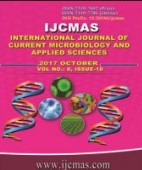


 National Academy of Agricultural Sciences (NAAS)
National Academy of Agricultural Sciences (NAAS)

|
PRINT ISSN : 2319-7692
Online ISSN : 2319-7706 Issues : 12 per year Publisher : Excellent Publishers Email : editorijcmas@gmail.com / submit@ijcmas.com Editor-in-chief: Dr.M.Prakash Index Copernicus ICV 2018: 95.39 NAAS RATING 2020: 5.38 |
Colours give delightful pleasure to eyesight but at the same time they may act as serious pollutants when their origin is dyes and dyestuffs. The textile industry is one of the industries that generate a high volume of waste water. Strong colour of the textile waste water is the most serious problem of the textile waste effluent. Total 26 bacterial isolates were isolated from fourteen different effluents and its contaminated and cultivated soil. Dye decolourization study was carried out using all 26 isolates with one dye (Red HE7B 100ppm) for checking potentiality of isolated bacterial isolates. After 10 days of incubation with bacterial isolates, 14 isolates gave satisfactorily decolourization above 70% compared with control. The morphological, microscopic and biochemical characterization of selected 14 bacterial isolates (Ps1 to Ps14) was carried out. All 14 bacterial isolates were found either circular or round in shape except Pseu-ghat-eff-4 which is found irregular in shape. All 14 bacterial isolates identified as Pseudomonas sp. The genomic DNA was isolated from 24 h old Pseudomonas bacterial cultures. The RAPD was performed using genomic DNA of 14 Pseudomonas sp. to generate diversified map and identification of specific markers associated with decolourization activity. Total 172 fragments were generated by 17 RAPD primers across 14 bacterial isolates. Out of 170 bands, 122 bands were shared polymorphic which was found at least more than two isolates and 48 bands were unique polymorphic bands. Jaccard similarity coefficient was found in the range of 0.137 to 0.368 in clustering pattern of 14 bacterial isolates. Best bacterial isolates, Ps4 with respect to dye decolourization was distinguished by 6 unique bands amplified by OPA-07 (356bp), OPA-18 (577), OPB-18 (1150), OPD-02 (2152), OPF-15 (1079) and OPZ-15 (2694bp) makers. However, Ps10 was distinguished by 4 unique bands amplified by OPF-06(1817bp), OPF-15(1535bp), OPO-06(2208bp) and OPO-13(484bp).
 |
 |
 |
 |
 |